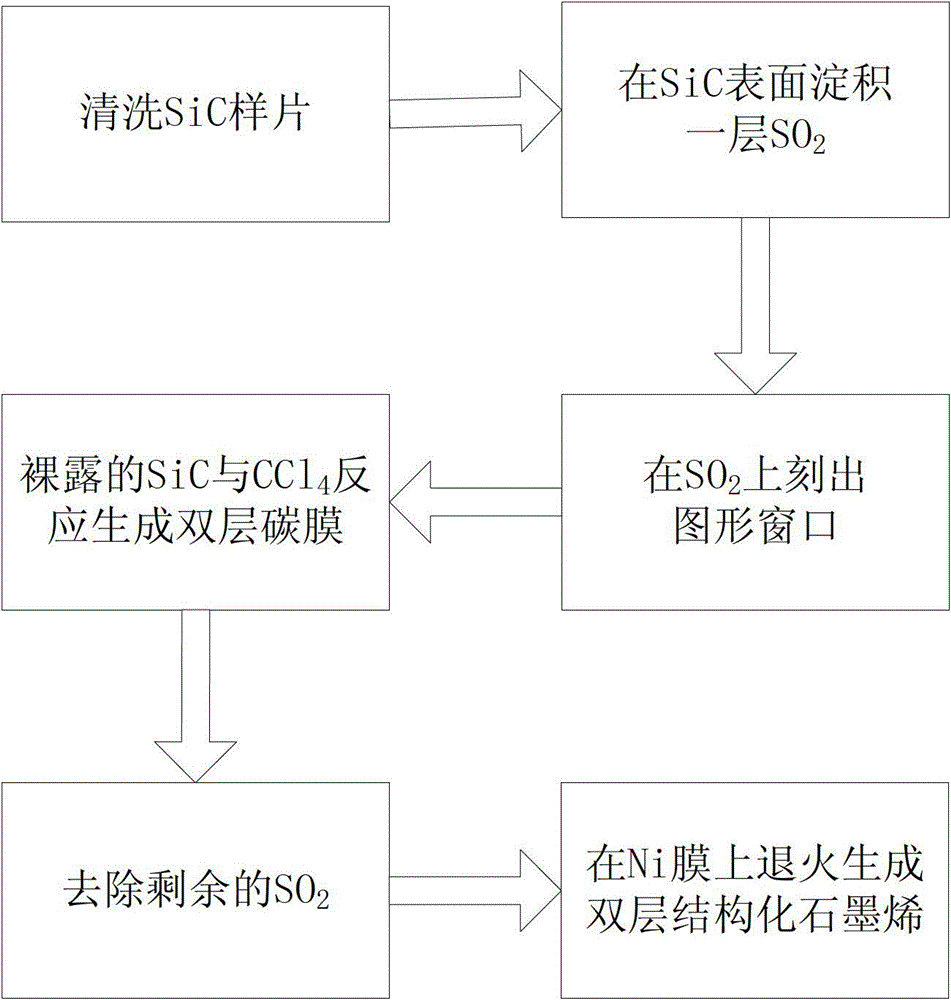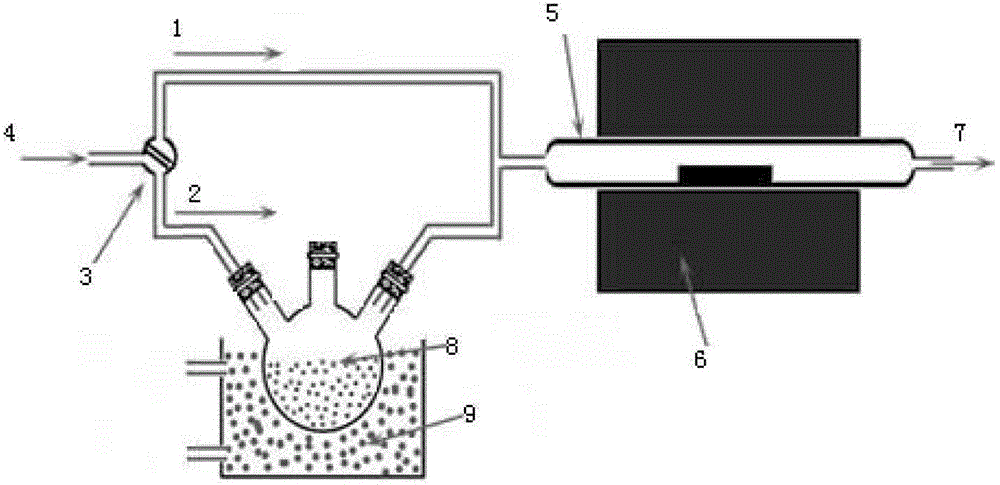Preparation method of structured grapheme on SiC substrate based on Ni membrane annealing
A structured and graphene technology, applied in the field of microelectronics, can solve the problems of complex process, high production cost, high energy consumption, etc., and achieve the effects of simple process, low porosity and high safety
- Summary
- Abstract
- Description
- Claims
- Application Information
AI Technical Summary
Problems solved by technology
Method used
Image
Examples
Embodiment 1
[0025] Step 1: Wash the 6H-SiC sample to remove surface contamination.
[0026] (1.1) Use NH for 6H-SiC substrate 4 OH+H 2 o 2 Soak the sample in the reagent for 10 minutes, take it out and dry it to remove the organic residue on the surface of the sample;
[0027] (1.2) Use HCl+H on the 6H-SiC sample after removing the surface organic residues 2 o 2 The reagent soaked the sample for 10 minutes, took it out and dried it to remove ionic contamination.
[0028] Step 2: Deposit a layer of SiO on the surface of the 6H-SiC sample 2 .
[0029] (2.1) Put the cleaned 6H-SiC sample into the plasma-enhanced chemical vapor deposition PECVD equipment system, adjust the internal pressure of the system to 3.0Pa, adjust the radio frequency power to 100W, and adjust the temperature to 150°C;
[0030] (2.2) Introduce SiH with flow rates of 30sccm, 60sccm and 200sccm into the PECVD system 4 , N 2 O and N 2 , for 20min, making SiH 4 and N 2 O reacts to deposit a layer of SiO with a t...
Embodiment 2
[0051] Step 1: Clean the 4H-SiC sample to remove surface pollutants.
[0052] For 4H-SiC substrates, use NH first 4 OH+H 2 o 2 Soak the sample in the reagent for 10 minutes, take it out and dry it to remove the organic residue on the surface of the sample; then use HCl+H 2 o 2 The reagent soaked the sample for 10 minutes, took it out and dried it to remove ionic contamination.
[0053] Step 2: Deposit a layer of SiO on the surface of the 4H-SiC sample 2 .
[0054] Put the cleaned 4H-SiC sample into the plasma-enhanced chemical vapor deposition PECVD system, adjust the internal pressure of the system to 3.0Pa, adjust the radio frequency power to 100W, and adjust the temperature to 150°C; the flow rate into the system is respectively 30sccm , 60sccm and 200sccm SiH 4 , N 2 O and N 2 , for 75min, making SiH 4 and N 2 O reacts to deposit a layer of SiO with a thickness of 0.8 μm on the surface of the 4H-SiC sample. 2 .
[0055] Step 3: On SiO 2 Spin-coat a layer of p...
Embodiment 3
[0066] Step A: Clean the surface of the 6H-SiC substrate, that is, use NH 4 OH+H 2 o 2 Soak the sample in the reagent for 10 minutes, take it out and dry it to remove the organic residue on the surface of the sample; then use HCl+H 2 o 2 The reagent soaked the sample for 10 minutes, took it out and dried it to remove ionic contamination.
[0067] Step B: Put the cleaned 6H-SiC sample into the PECVD system, adjust the internal pressure of the system to 3.0Pa, adjust the radio frequency power to 100W, and adjust the temperature to 150°C; the flow rates into the system are respectively 30sccm, 60sccm and 200 sccm of SiH 4 , N 2 O and N 2 , for 100min, making SiH 4 and N 2 O reacts to deposit a layer of SiO with a thickness of 1.2 μm on the surface of the 6H-SiC sample. 2 .
[0068] Step C: Same as Step 3 of Example 1.
[0069] Step D: Place the windowed sample in the quartz tube 5, and place the quartz tube in the resistance furnace 6; then put the CCl 4 Liquid is pac...
PUM
 Login to View More
Login to View More Abstract
Description
Claims
Application Information
 Login to View More
Login to View More - R&D
- Intellectual Property
- Life Sciences
- Materials
- Tech Scout
- Unparalleled Data Quality
- Higher Quality Content
- 60% Fewer Hallucinations
Browse by: Latest US Patents, China's latest patents, Technical Efficacy Thesaurus, Application Domain, Technology Topic, Popular Technical Reports.
© 2025 PatSnap. All rights reserved.Legal|Privacy policy|Modern Slavery Act Transparency Statement|Sitemap|About US| Contact US: help@patsnap.com


